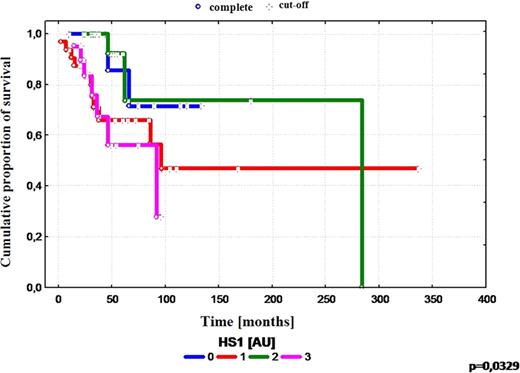Abstract
Abstract 2853
B-cell chronic lymphocytic leukemia (B-CLL) is the most common leukemia in adults in western countries. It is characterized by B lymphocyte accumulation in peripheral blood, bone marrow, lymph nodes and other lymphatic organs. Leukemic cells derive most commonly from B lymphocytes, rarely from T or NK cells. B-CLL is known from its heterogeneous clinical course from indolent to very aggressive. In spite of many known prognostic factors (such as immunoglobulin heavy chain gene mutational status – IgVH, expression of ZAP70 and CD38), is still difficult to classify a single patient to particular risk group and to predict CLL clinical course. That is why new prognostic factors are still needed.
HS1 (hematopoietic cell specific Lyn substrate-1) is an intracellular protein, which expression occurs mainly in hematopoietic cells. HS1 plays an important role in regulating T cell immune synapse and affects many functions of NK cells, including the lysis of target cells, adhesion, chemotaxis and clustering of actin in the lytic synapse. The role of HS1 in B cells is poorly understood. This protein was identified in B cells as the primary receptor substrate for phosphorylation by BCR after antigenic stimulation. Other studies have confirmed the role of HS1 in the process of clonal expansion and deletion induced by antigen-receptor interaction in B cells and T. HS1 is rapidly phosphorylated in B cells in the vicinity of tyrosine residues and is a substrate for tyrosine kinases: the Src family and Syk, including Lyn, FGR, Fyn and Lck. It has been shown that HS1 interacts with the cell cytoskeleton in both: normal and leukemic B cells. HS1 protein is an important regulator of motility, migration and adhesion of leukemic cells and is involved in cytoskeleton rearrangement. HS1 can have impact on homing and migration of CLL cells. It can indirectly promote disease progression and influence patient survival.
of this study was to evaluate HS1 expression in CLL patients in connection with other known prognostic factors and patient survival.
92 untreated CLL patients (45 women and 47 men), aged between 42 and 88 years (median age 67 years), were included into the study. Diagnosis was made basing on typical clinical, hematological and immunophenotypical picture. The control group was consist of 28 healthy matched people (11 men and 17 women), aged between 36 and 79 years (median age 59 years). HS1 protein expression was determined by western blot. Comparative semi-quantitative indication of the degree of saturation of the bands analyzed by densitometry using the gel documentation system Gel-Doc (Bio-Rad) and a computer program to analyze the 1-D Quantity One (Bio-Rad). Assuming conventional units [AU - arbitrary units], depending on the saturation band, patients were divided into four groups with the expression of HS1 protein expressed in value from 0 to 3. Lack of expression was expressed as 0 [AU], and expression of the strongest, with the highest saturation band measured as 3 [AU]. Mutational status of IgVH, as well as CD38 and ZAP70 expression were also analyzed.
HS1 expression was significantly higher in CLL patients comparing to controls. Positive correlation was shown between HS1 and: age (p=0.0454), Rai stage (p=0.0412), leukocytosis (p=0.0129) and β2-microglobulin (p=0.0342). There was negative correlation between HS1 and hemoglobin level (p=0.0464) and platelet count (p=0.0310). Patients with lymphocyte doubling time shorter or equal to 6 months had higher expression of HS1. Expression of HS1 significantly influenced survival of CLL patients. Patients with higher HS1 expression had shorter survival than those with lower HS1 expression (p=0.0329).
1. Higher HS1 expression is observed in more advanced CLL stages.
2. Expression of HS1 in CLL cells is matched with shorter patient survival
The relationship between expression of HS1 and survival of patients with B-CLL.
No relevant conflicts of interest to declare.
Author notes
Asterisk with author names denotes non-ASH members.


This feature is available to Subscribers Only
Sign In or Create an Account Close Modal